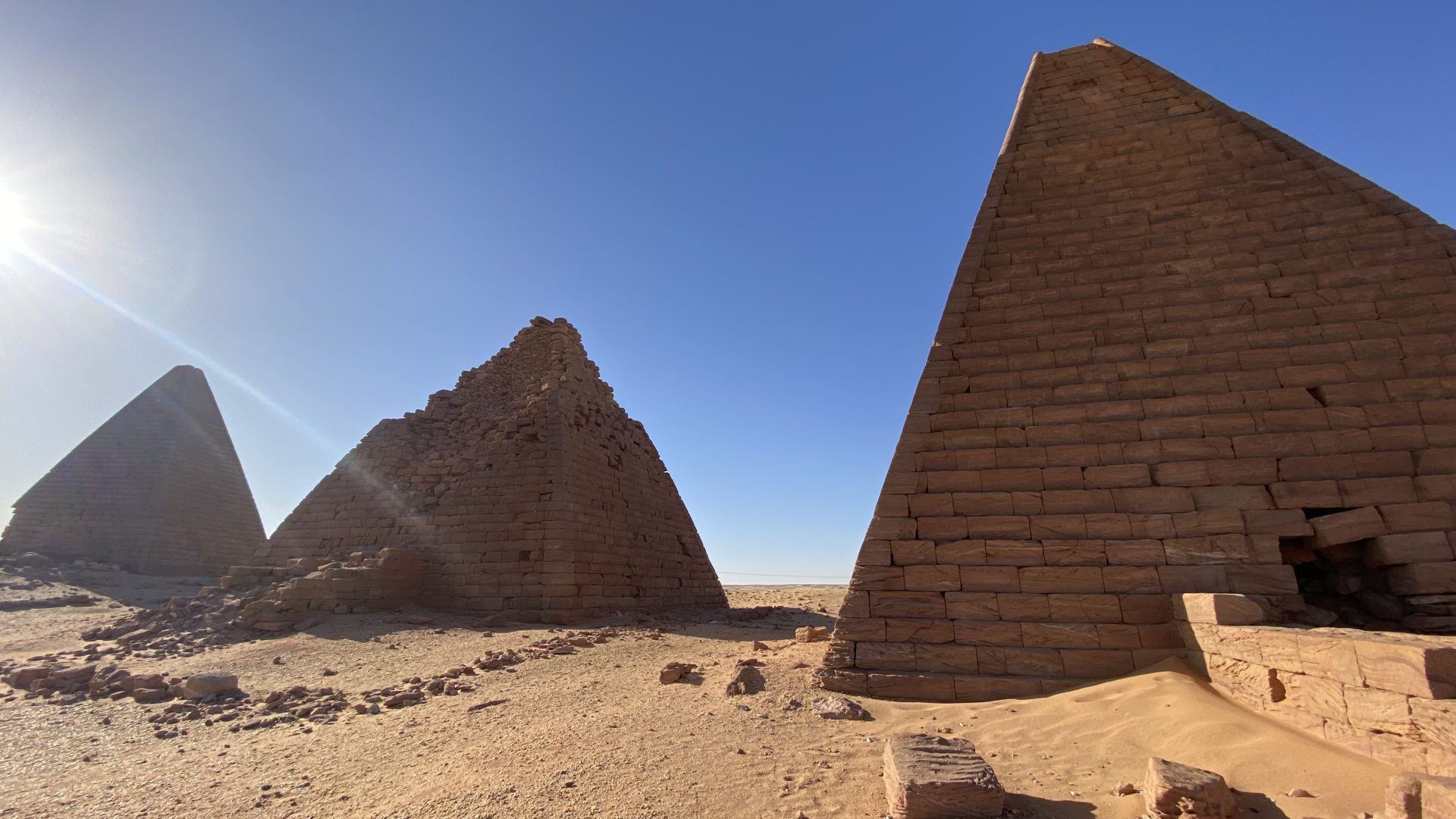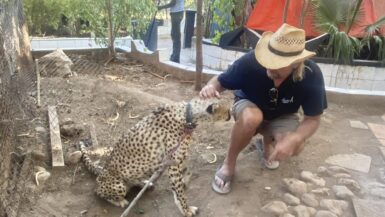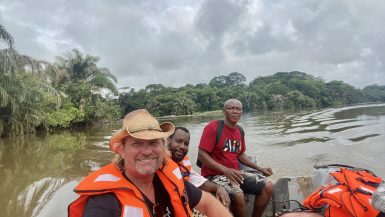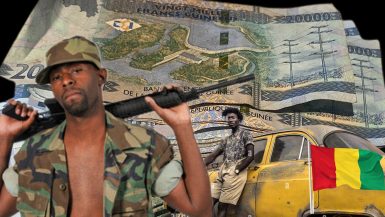The Ancient Kush Empire
As I rode the camel around the edge of the hill, I wasn’t prepared for the scene that appeared before me: golden sand dunes topped with pyramids as the sun cast its final rays. The burial site of the ancient kings is far off the main tourist routes but it is jaw-dropping. I have never seen anything like this ancient alien landscape in all my travels.
However, Sudan isn’t for everyone. If you’re looking for frozen drinks on the beach and a beautiful hotel room, point your map cursor to one of Egypt’s Sharm-el-Sheik resorts. Sudan has been embroiled in civil war and coups for decades and hasn’t really invested in its tourist infrastructure. There’s also a language barrier. Having said that, if you’re a seasoned traveler that’s seen Egypt, Lebanon and Jordan (and you want more), Sudan will blow you away. Really.
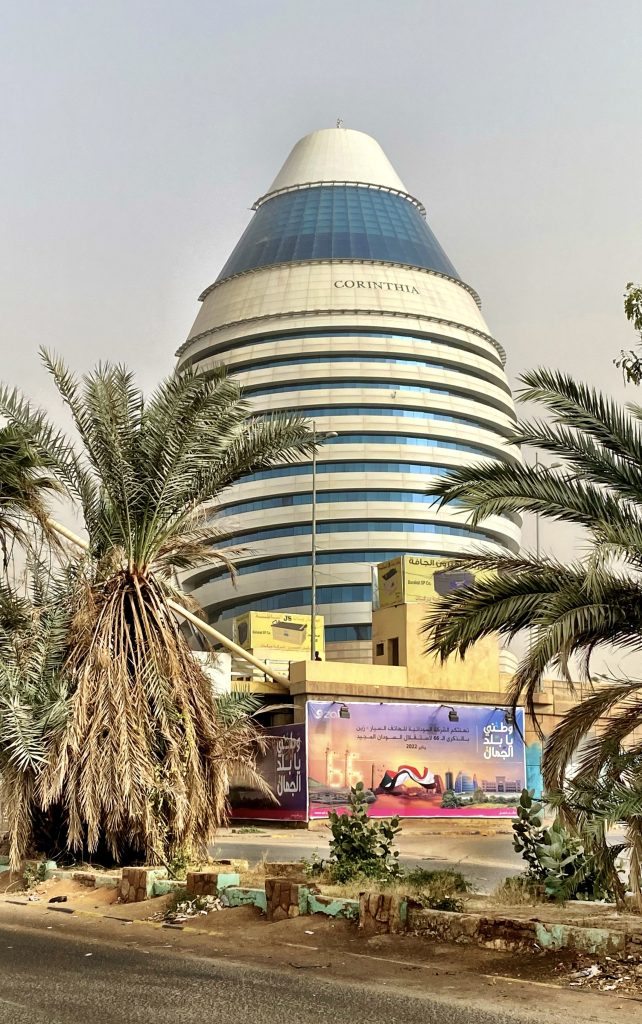
To get there, you can use a hub such as Cairo, Jeddah or Istanbul. Visas are procured the old-fashioned way. Photos, application, letter of invitation, itinerary, all mailed to the Washington Sudanese Embassy with a SASE. Once all that’s out of the way, and you’ve arranged your tour, you’ll want to fly to Khartoum and meet your tour agency. I used Raidan Tours and paid $900 for a 5 day trip including hotels, transport, permits and some meals. Considering the fact that renting a car without a driver (which is nearly impossible) costs $100/day, it’s a pretty sweet deal.
There are lots of travelers who have managed to get around using local transport and hitchhiking, but if time is an issue, a tour will leave and return when you choose and you won’t be crammed in a minibus in the sweltering heat. Sudan weather can be a killer.
Sudan is a vast country and I only visited the must-see stuff on this adventure. Most of my journey was me traveling alone with a driver who spoke reasonable English, but wasn’t much for small talk or being a guide. Other than pointing to the signs and making sure I ended up in the right place on time, I was mostly reading Wikipedia to learn what I could about Meroe and the Kush kingdom.
Before we started on our adventure, a rep picked me up at the airport and checked me into a room at the Khartoum Plaza, an aging but pleasant enough hotel that offers free breakfast, towels, hot water and a western toilet. There’s a TV too, but the programming is in Arabic. There’s a couple of high end hotels in town, most notably Corinthia Hotel.
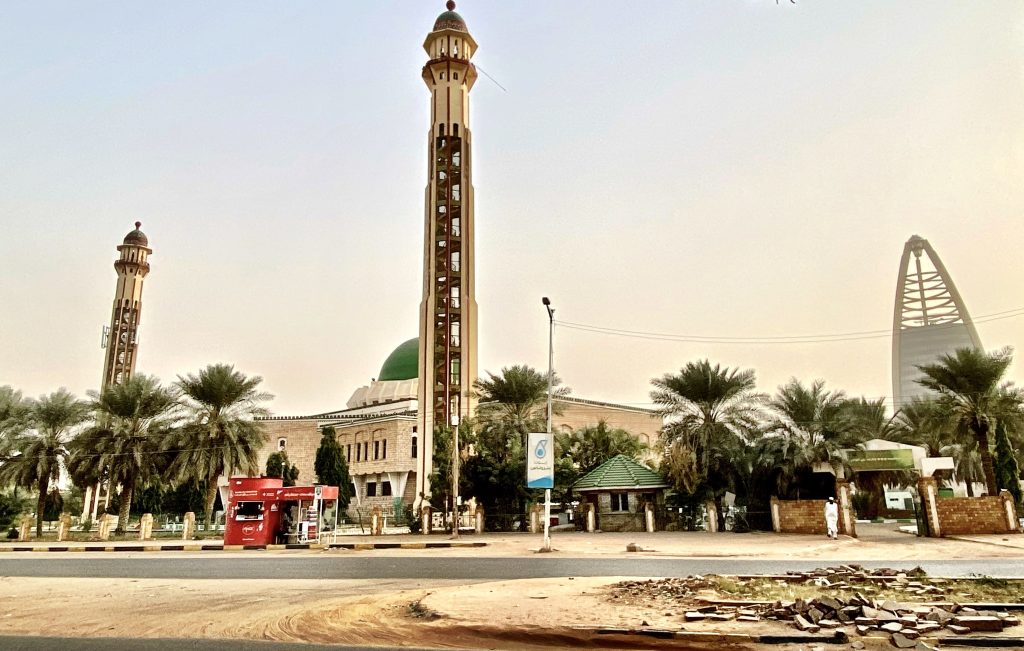
It’s a good idea to bring a sleeping sheet for budget hotels. Out of the three hotels I stayed, there was only a single sheet on the mattress. It was unclear whether you’re expected to sleep on it or under it. You also need to make sure you bring cash and a have VPN app on your phone. You can’t book hotels online, ATMS don’t work at all and neither do many websites including the App Store without a VPN. You can buy a SIM card easily enough to be connected when you’re near a town. Your US phone won’t work otherwise. I brought a second phone (and used a local SIM) to use as a hotspot for my primary phone.

Khartoum can be a little intimidating when you first arrive. Some of the streets have a considerable amount of trash, theres dilapidated buildings and wrecked cars. On busy days, the traffic is crazy with pedestrians, tuk tuks, goats and an occasional donkey cart in the street. There’s an Arabic-African fusion vibe and the streets are full of people selling things or walking around looking at the foreign person who just strolled into town. I never felt threatened, but I also never felt like I could just hang out with locals. I don’t speak Arabic, and Google translate isn’t quite smooth enough to allow me to talk about my hopes and dreams to a person I’ve just met. My take is the Sudanese are a laid-back people that ask nothing from you except a hello. All transactions are handled with a smile. I never saw any bribes being extorted or tips demanded like is common in other parts of Africa.

I was anxious to get going to the archaeological treasures so we left the following morning. It’s about a four hour drive to Naqa, to see the temple of Amun. Nearby is the Roman temple and lion chapel. There’s not much to see along the way except a few dusty towns, but the ruins are magical and you’ll have them to yourself.

Musawwarat is next on the list. A guardian let me into the locked temple and showed me the elephants and other creatures carved into the walls. It’s hard to imagine African animals in such a desert, but all evidence points to lions and elephants having a presence here. From there we passed through the biggest town in the area, Shendi, which is a good place to stretch your legs, catch a bus or grab some food and a cold drink.
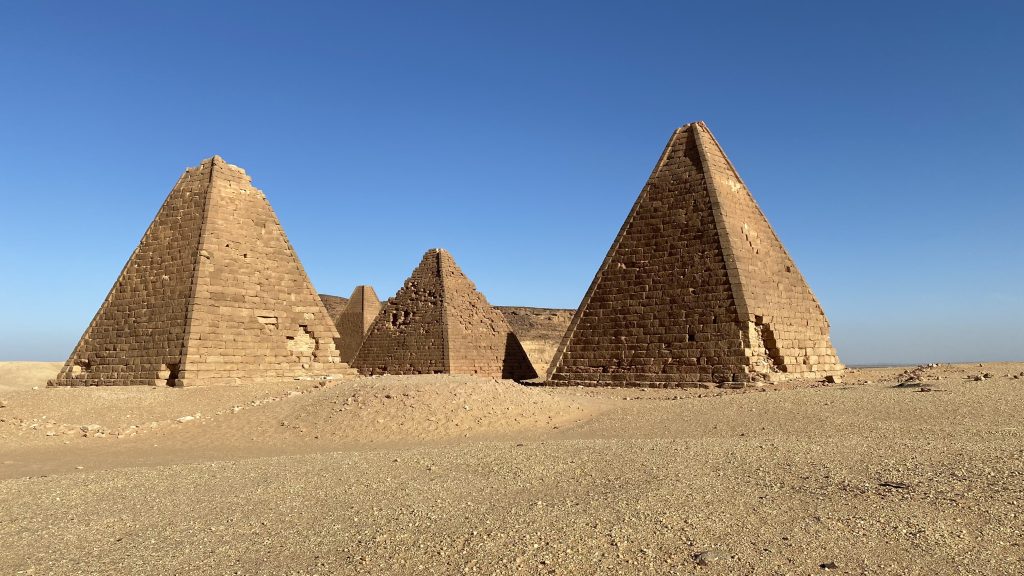
Our next stop was the headliner, Meroe. This place is absolutely amazing. If the location scouts for Indiana Jones and Star Wars got together, they couldn’t find a better setting. There’s two sites a few hundred yards apart. One is what appears to be black pyramids (from a distance) and the other a mix of temple facades and pyramids in all shapes and sizes. There’s simply nothing like this anywhere in the world. The site gives off an “alien race on another planet” vibe. From the visitors center parking area, you can walk or take a camel to the ruins. If you’ve traveled before, you know camel prices are VERY negotiable. We arrived about an hour before sunset. There’s simply no better time to take photos there.
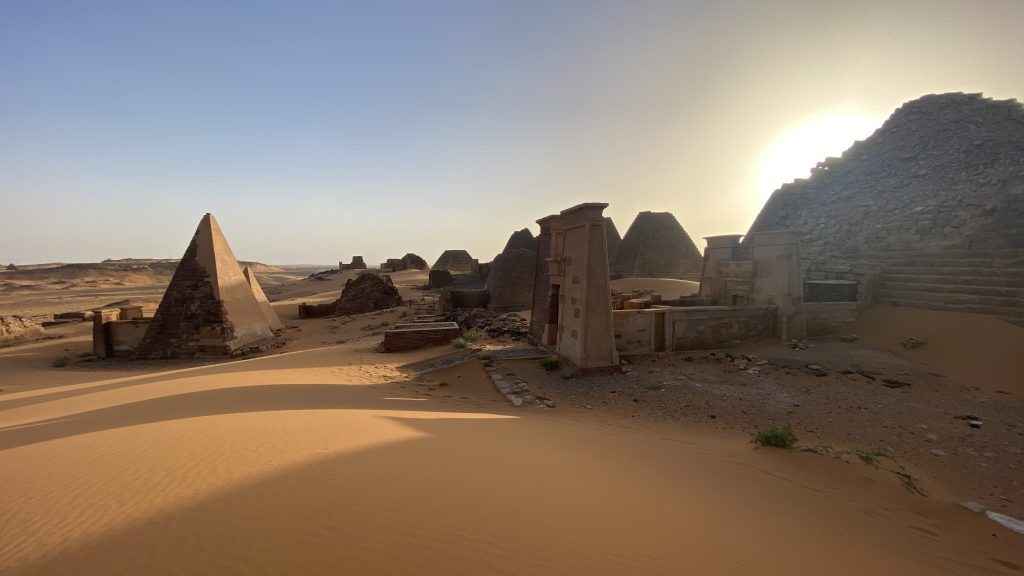
Raidan Tours owns its own accommodation within view of the black pyramids. There’s not much to be said for the décor or the bedding, but it was clean and since I was the only guest that evening, I had a “private chef” cook for me.
It’s hard to beat an attraction like Meroe. Even the pyramids in Egypt don’t look as cool. I half expected the next day to not be very impressive. I was wrong.

We visited two other pyramid sites, Nuri and Jebel Barkal. Both are very different from Meroe and impressive in their own right. Jebel Barkal (Barkal mountain) has an Amun temple complex on the other side of the mountain from the pyramids that’s currently undergoing a restoration. It’s mostly fallen walls and pillars, but it’s interesting to walk around and imagine it’s history.

The last attraction that day was El-Kurru. My driver stopped in front of a large black pyramid and I got out and started walking towards it. To my right was a clay half cylindrical shaped structure that looked like something Luke Skywalker might live in. As I approached the pyramid, the “key-master” of the area motioned me back to the clay building. I assumed that there were maybe some carvings being protected by the roof. He motioned me inside. To my surprise, there were steps leading underground to ã subterranean room. It seemed impossible that what seemed like nothing above had this long deep passageway. I descended at least 25 feet and walked into a room covered with hieroglyphs. This tomb was that of King Tanwetamani and looked as cool as anything I’ve seen in Egypt. Unlike Egypt, there was no plexiglass panels, hordes of tourists, or guides bugging me for a tip. Being alone with this ancient art is an amazing feeling. These paintings were created a thousand years before Jesus was born. Preserved, under the earth, to be found three millennia later. Wow. Double wow.
That night we stayed in a Nubian home. It is similar to a Moroccan Riyad; a courtyard with rooms surrounding it. The upside to having six beds in your room is that you can borrow the sheets from them so you don’t freeze when the temperatures drop. The bathrooms are simple with no hot water and a squat toilet. We went to the equivalent of an outdoor food court in Karima. There was a disemboweled goat hanging next to the roasting area with fur still intact and bright shiny testicles protruding from his three-legged carcass. I ordered the chicken.
It’s a long hard drive back to Khartoum from Karima with not much to see except scrubby desert. My itinerary was 5 days. There are much longer trips that explore various tribal regions as well as Port Sudan at the Red Sea if you wish to see more of the country. A few regions are completely off limits due to political unrest.
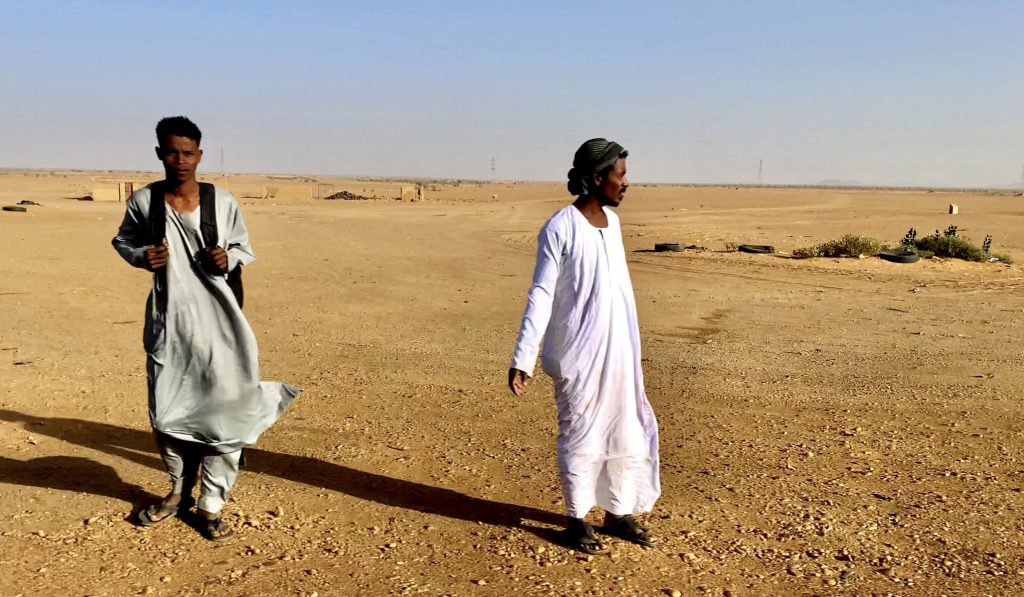
In Khartoum there’s a few things to see. You can hire a boat near the bridge for $12 to take you to see where the blue and white Nile meet. It’s not terribly exciting, but it’s nice to see the Nile from… the Nile. There’s also two museums, the highly rated National Sudan museum and the Khalifa house. Both were closed indefinitely for maintenance during my visit (with no sign of any maintenance actually happening). The market can be fun and there’s a weekly camel market In Omdurman. There’s also a fish market, mosques, mosques and more mosques.

Let Me Help you travel more and Better!
Easily customize your trip with the best hotels and flight deals


